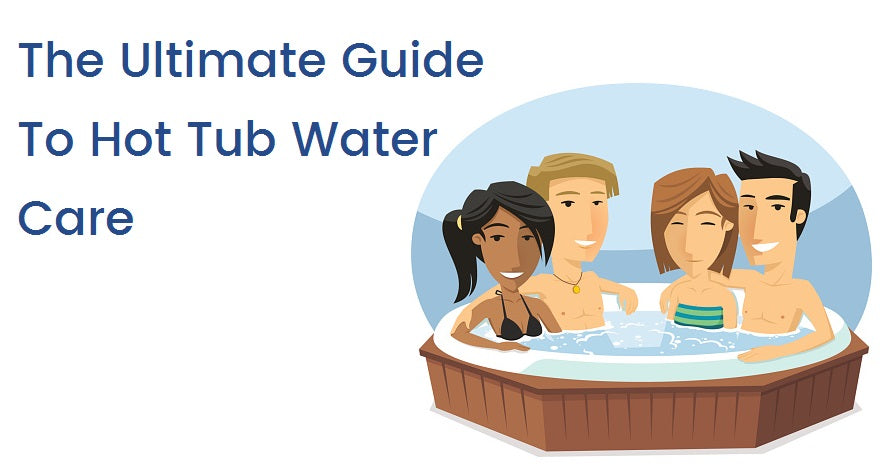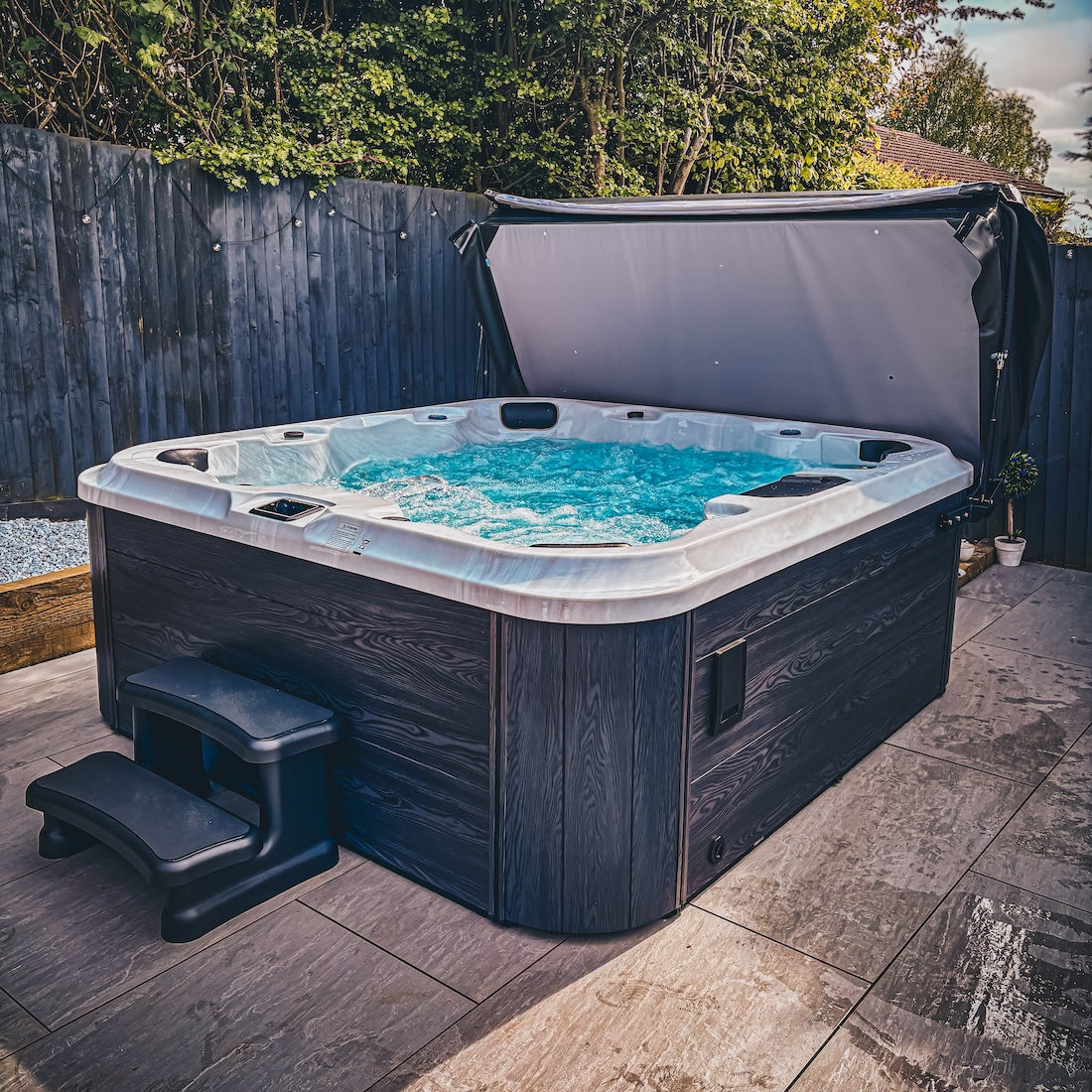
How hard is it to take care of a hot tub?
It's a question we're asked a lot here at H2O Spa. Learning how to manage the water chemistry in your hot tub isn't a particularly difficult task - anybody can do it!
Don't worry, you don't need a lab coat and goggles. This guide will help you to understand the basics of chlorine and pH levels, stabilisers and shock treatments.
Alkalinity
When it comes to your hot tub's water chemistry, you want to check the water's alkalinity first. You need to check this before your pH levels - why? Proper alkalinity levels will help to stop fluctuating pH levels in your spa water. If your alkalinity and your pH became too high, the disinfectants in the chlorine you add won't be as effective. You'll then get issues like cloudy water in your hot tub, and it can even lead to skin or eye irritation. You may also get scaling build-up in your heating system, which causes it to be less efficient.
How To Balance Alkalinity
1. Get a test strip. Make sure you don't touch the testing area if you've got wet hands from the hot tub water as this could make the test pointless.
2. Dip the strip. Place the strip into the water, and then remove. Shake the excess water from it and compare it the colours on the back of the test strip bottle.
3. Alkalinity too low. If your alkalinity is too low, use some Total Alkalinity increaser. When adding it to the water, follow the instructions on the back of the bottle.
4. Alkalinity too high. If your alkalinity level is too high, this could mean you have particularly hard water in your area. Contact us to discuss the best thing to do.
Remember: when you add chemicals to your hot tub, allow the water to circulate around the system for a couple of hours before re-testing, so you get more accurate readings. Changes won't be immediate. Never add more than one chemical at a time.

pH Levels
Before you add any sort of sanitiser to your hot tub (chlorine or even bromine) you need to check your pH levels first, in order to see how acidic or basic your water is. The ideal range is 7.2 - 7.8. If your pH level is significantly below 7.2 then your water is definitely too acidic. This can affect the water chemistry in your spa and can cause irritation and potentially damage due to equipment corrosion. If your pH levels are too high, your water is too alkaline (basic) and this can cause your water to become cloudy and again can cause irritation.
How To Balance Your pH Levels
1. Get a test strip. Make sure you don't touch the testing area if you've got wet hands from the hot tub water as this could make the test pointless.
2. Dip the strip. Place the strip into the water, and then remove. Shake the excess water from it and compare it the colours on the back of the test strip bottle.
3. pH levels too low or high. If your levels are too low (below 7.2) then use some pH increaser. If too high (above 7.8) then use pH decreaser to bring levels back tot he recommended range and balance the water.
4. Add your chemicals. Once you've worked out whether or not you need pH increaser or decreaser, follow your instructions to add more chemicals.

Sanitisers - Chlorine v Bromine
Whilst hot water can kill a lot of bacteria and viruses, many are able to survive. For that reason, you need to santise your water to make sure it is clear, fresh and disinfected. The most popular sanitisers around are chlorine and bromine. There are benefits of both.
Bromine is more complex than Chlorine and can take much longer to dissolve in your spa's water. The costs of Bromine are lower, but you'll get that money back over time as there are less treatments required.
Chlorine is the easiest to apply and will take effect much quicker. It dissolves faster than Bromine so you can use your spa after appling much faster. It's cheaper than Bromine, but requires a little more maintenance.

Shock
It's very important to shock your hot tub water from time to time, it's an essential part of hot tub water maintenance. Don't worry, we know it sounds violent, but what shock does it breaks down all the organic contaminants that can lead to cloudy water and smelly odours. Shocking your tub oxidises the contaminants and releases them in gas form. Shocking your hot tub will reduce the requirement for high chemical dosage, helps to kill bacteria, viruses and even algae. It will also prolong the life of your hot tub parts.
We recommend you shock your hot tub at least once per week to keep your water clean, fresh and clear. This will obviously vary depending on how often you use your hot tub and how many people use it. There are two kinds of shock: non-chlorine shock and dichlor shock. We recommend the non-chlorine shock. It's a monopersulfate compound, chemistry fans, and is oxygen-based and is the best one for the job.
How To Shock Your Hot Tub
1. Test the water. Before you shock, always test your hot tub's water, as with any chemical addition that you ever make.
2. Keep water calm. You don't want to disrupt the oxidisation gases, so turn off your air blower, but leave the circulation pump on. This means the shock can circulate around the spa, but not stir the gas up too much.
3. Read the label. Always, always read the labels on chemicals. If you measure incorrectly you could end up having a stronger oxidisation strength than you need, which can lead to problems for you and your hot tub.
4. Measure with care. When it comes to shocking your hot tub water, the dosage is very important. Carefully measure out your shock treatment to make sure you're only adding what you need to disinfect the water.
5. Wash your hands. With all chemicals, you should wash your hands, with soap, after coming into contact. You don't want any shock still lingering on your fingers.

Draining your hot tub
After a while, the water chemistry in your hot tub can be too difficult to balance, and it needs to be reset. We recommend you drain and refill your hot tub every three months. Replacing the water will flush out all the pipework and pumps, and generally freshen everything up.
Make sure that you do a complete drain. Don't just drain half the water out. Give your hot tub, when empty, a deep clean to remove any surface stains and avoid corrosion. When you've drained it, use pipe cleaning fluid to clean out the plumbing inside the spa. Read our guide to cleaning your hot tub.

Got any questions?
We're always happy to help our customers and any hot tub customer who has concerns or questions about their water chemistry. It may seem like a lot of work after reading the above, but it's really not. Once you're in a decent routine, it will take a couple of minutes a week to keep your water fresh, clean and healthy.
If you have any questions, please give us a call.


